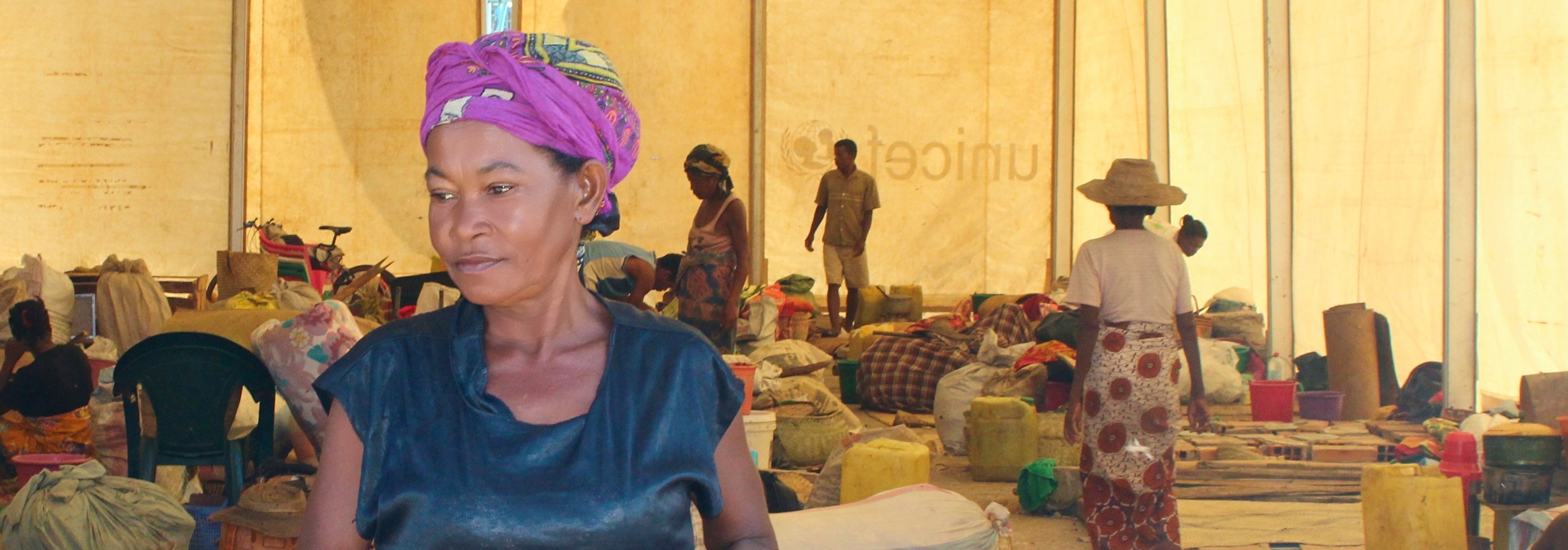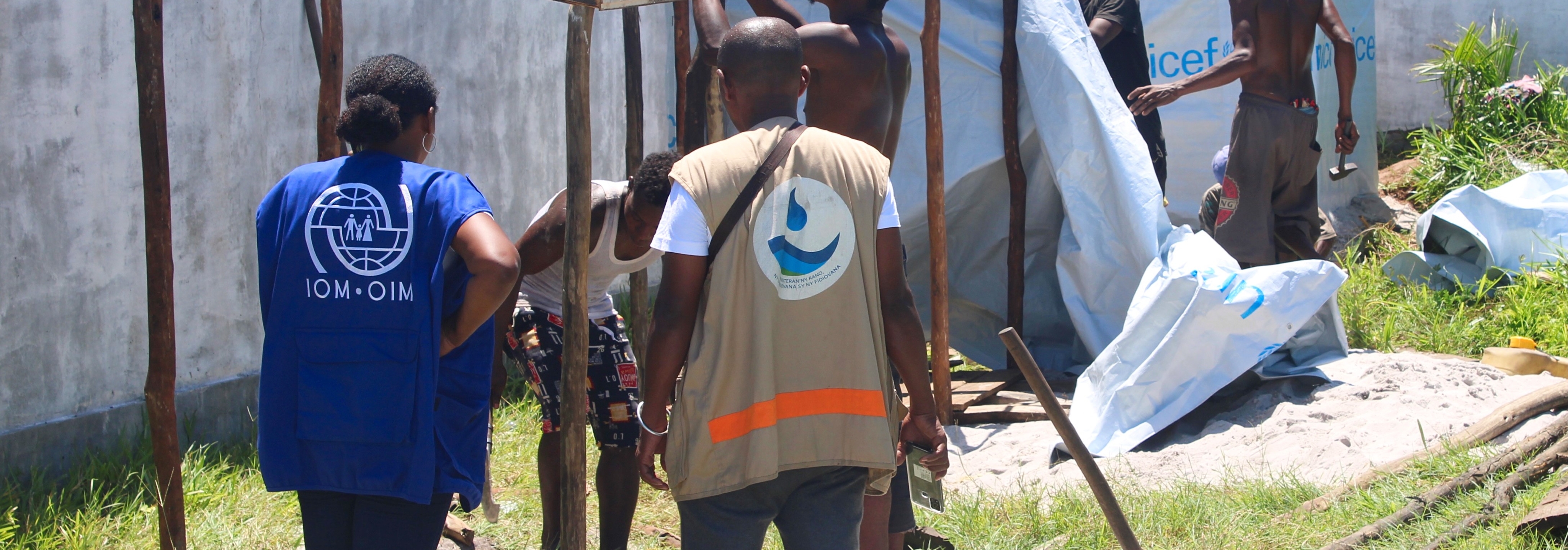IOM Vision
IOM Madagascar works to ensure that migration to, from and within Madagascar is a choice, not a necessity. The Organization works closely with state actors, other UN agencies and non-profit organizations to provide direct assistance to migrants and internally displaced persons, to address the adverse drivers of migration and to reduce tensions in destination communities.
Objective
Saving lives and protecting people on the move
IOM will work together with the Malagasy government in the areas of protection, movement assistance, cash and voucher assistance (CBI), shelter and CCCM, targeting the following groups and entities:
- Internally displaced persons (IDPs) forcibly displaced because of disasters (including food insecurity);
- Local communities and local authorities in areas affected by disaster; and
- Internal migrants
To support the mental health and psychosocial needs of people in need IOM will:
- Establish clear communication pathways and referral procedures with partners to facilitate access to services (medical and mental health and psychosocial support) for IDPs and host communities in need of support.
IOM will enhance the capacities of Camp Coordination and Camp Management of the relevant actors, including the national and regional government bodies through:
- Trainings on management and coordination of the assistance; and
- Services and protection activities on camp management such as spontaneous sites, collective and transit centres.
IOM provides displaced populations and those impacted by disasters with prompt access to emergency and more durable shelters that ensure safety, health, privacy and dignity. Shelter activities mainstream early decampment and recovery strategies, maximizing community-driven approaches and considerations to affected populations with increased socioeconomic vulnerabilities. IOM will:
- Provide shelter materials based on the local context, needs, and Cluster recommendations, including Shelter Strengthening Kits (SSK), Shelter Repair Kits (SSK) and emergency shelter kits;
- Provide support through cash-based interventions, including cash grants and vouchers, to augment basic needs such as the purchase of shelter materials, household items, hiring of skilled labours to support shelter repair or construction, debris removal, renting of accommodation, etc;
- Provide technical assistance, including damage assessments, building performance, research, evaluations, designs, specifications, promotion of indigenous practices, affordable and replicable construction systems, market assessment, labour and supply chain assessment, technical training, IEC materials development and dissemination, analysis of community-based disaster risk management through settlements approach, etc; and
- Conduct technical audits on shelters repaired by communities to ensure compliance with SPHERE standards and other safety protocols.
IOM will ensure that protection principles are mainstreamed across interventions to ensure safety and dignity, avoid causing harm and guarantee meaningful access to assistance for all persons in need, without discrimination. This includes GBV risk mitigation as well as Disability Inclusion throughout the program cycle. Particular attention will be given to effective participation and empowerment of the community, ensuring that Complaint and Feedback Mechanisms (CFM) and other reporting mechanisms related to Prevention against Sexual Exploitation and Abuse (PSEA) and the Child Safeguarding Policy are in place to prevent misconduct and guarantee accountability to affected populations, in line with the IOM Accountability to Affected Populations Framework. As such, IOM will:
- Ensure that staff and implementing partners have an appropriate PSEA response in place and are duly trained on how to prevent, respond to, and report SEA incidents while populations are aware of SEA policies, reporting channels and services available for victims. This will be achieved through the development of an action plan including capacity-building and awareness-raising;
- Build on its collaboration with the Government of Madagascar and the existing National Action Plan and dedicated institutions to fight trafficking in persons to advance the anti-trafficking agenda and strengthen prevention and protection efforts; and
- Provide assistance to victims of trafficking (VoT) according to the needs identified, which could include for instance medical, mental health and psychosocial support; referrals to specialized services and partners; safe shelter; and transportation and reintegration assistance for return into the community of origin.

Objective
Driving solutions to displacement
IOM will support the Malagasy government by implementing activities in the areas of resilience including peacebuilding and peace preservation, and community stabilization, cash and voucher assistance (CBI) targeting:
- Local communities in the regions characterized by migrant outflows, as well as in the regions of destination;
- Internal migrants and internally displaced persons (IDPs);
- Security and defence forces working in the regions affected by insecurity.
To improve stability within communities most vulnerable to, or impacted by, drought-induced internal migration, IOM will undertake community stabilization initiatives that promote and enable local adaptation and resilience, including:
- Promote social cohesion activities through peace rituals and activities aimed at community stabilization, notably by establishing women's committees; and
- Create neutral, inclusive, open spaces through community peace committees and other platforms in partnership with law enforcement to identify and resolve safety and security issues.
- Implement cash-based interventions to assist local populations
IOM Madagascar will implement peacebuilding activities to prevent and resolve tensions and insecurity both by addressing drivers of displacement and supporting sustainable peace between migrants and destination communities. Key interventions in this area will include efforts to:
- Support initiatives aimed at building trust with the communities of the Andriry mountain range through the implementation of joint "general police" rounds (State representative, communal leaders, Defence and Security Forces (DSF), Decentralised Technical Services, etc.);
- Support the implementation of civil-military activities (e.g. medical, education and agriculture fields) and the community policing approach; and
- Facilitate the deployment of social and administrative services by setting up infrastructure and improving the mobility of DSF agents.
Objective
Strengthen preparedness and reduce disaster risk
IOM will work in the areas of preparedness and risk reduction, points of entry, and emergency preparedness, targeting:
- Internal migrants and IDPs;
- Local authorities and village committees;
- Victims of trafficking in persons and migrant smuggling;
- Border management stakeholders.
Given IOM leadership and active engagement on the recently completed CADRI and risk-informed planning work with UNDRR and UN partner agencies, IOM will work to reduce disaster-induced displacement arising from natural hazards such as cyclones, floods and wildfires through improved disaster risk management, preparedness and response inclusive of the implementation of early warning systems. IOM will also assist communities to strengthen resilience as part of the recovery and reconstruction process, in line with the Sendai Framework for Disaster Risk Reduction. Activities will include to:
- Provide hazard-resistant temporary shelters for housing (while integrating Disaster Risk Reduction (DRR) measures);
- Strengthen the capacity of government and humanitarian actors in risk-sensitive policies and strategies, DRR and protection measures and policy development;
- Provide trainings on disaster risk reduction (DRR) to crisis-affected communities as part of CCCM and evacuation, shelter response and recovery programmes;
- Support the draft, review and update of local policies on disaster risk reduction and management and local climate change adaptation planning and strengthening the implementation capacities of local actors through the provision of training, equipment and tools;
- Conduct research and actions related to Climate Change Adaptation (CCA) and contribute to the generation of relevant science-based evidence and utilization of local knowledge to inform the government’s policies and programmes;
- Conduct advocacy work for policies and research related to CCA;
- Conduct consultation with communities vulnerable to climate risk to develop community action plans that identify localized climate adaptation strategies, and provide technical assistance to implement these plans;
- Support at-risk communities and individuals to mainstream climate-smart, green livelihood strategies;
- In response to drought, seek more permanent solutions for water shortages including rehabilitation of large- and small-scale non-functional water schemes or drilling of new boreholes; and
- Population mobility mapping and strengthening the capacity of health systems, including border health systems to prevent, detect and respond to disease outbreaks and health threats, including through the strengthening of disease surveillance systems as well as community-based surveillance.
IOM will work with national and local authorities and communities to enhance their capacity in anticipating, responding to, and recovering from an emergency. IOM will:
- Work with government stakeholders in multiple sectors to enhance the coordination mechanism for emergency response and to support the drafting, updating and implementation of local contingency plans;
- Strengthen engagements with international and national partners, including with diaspora and private sector platforms in view of identifying and mobilizing viable, additional resources to complement the government’s efforts on emergency preparedness and response;
- Capacitate government stakeholders on national CCCM Guidelines and National Shelter Frameworks and support their operationalization at the local level, inclusive of Mass Evacuations in Natural Disasters (MEND) Guide and MHPSS trainings;
- Conduct social activities that seek to prepare communities for potential emergencies including through mapping of available local markets and service providers and orientation sessions on access to and proper usage of available assistance, services and resources during emergencies;
- Support the assessment and mapping of local disaster risks and the conduct of contextualized, community-based emergency preparedness management simulation exercises;
- Contribute to improving understanding and awareness of local communities and authorities on climate risks, including their interrelations with conflict and other causes that influence their vulnerabilities; and
- Preposition lifesaving and humanitarian relief goods in strategic, disaster-prone areas, which are ready for deployment at the time of disasters, including key Shelter and NFI materials.
Objective
Contribute to an evidence-based and efficient crisis response system
IOM will conduct Displacement Tracking Matrix (DTM), including Stability Index exercises, population mobility monitoring for drought crises, internal mobility monitoring for crisis-affected populations, and regular rapid multi-sector assessments of locations where large numbers of IDPs or internal migrants are relocating, providing mobility-related data to:
- Government counterparts;
- UN agencies;
- NGOs providing humanitarian and development support.
IOM will utilize Displacement Tracking Matrix (DTM) to:
- Collect data at the district, commune, fokontany and household levels through the Displacement Monitoring Matrix (DMM) tool. The DTM will provide detailed data on the profile of IDPs, protection needs and vulnerabilities of populations in displacement sites and host communities for targeted assistance by humanitarian actors. DTM will collect information on the localities and communities of origin, transit and destination most affected by displacement and possible return movements;
- Provide weekly demographic data on large population movements, define the main departure, transit, and destination points of IDPs, and identify protection needs and vulnerabilities of populations in displacement sites and host communities for targeted assistance by humanitarian actors, using the Emergency Tracking Tool (ETT); and
- Conduct a Stability Index exercise that will help to understand the relative level of stability in the target areas. The Stability Index combines 36 key stability indicators to calculate a single stability score for each location studied. These indicators are linked to three themes central to stability: safety and security, livelihoods and basic services, and social cohesion. The information gathered will identify key areas for further intervention by the UN system as well as state actors in the country.
Madagascar
The map used here is for illustration purposes only. Names and boundaries do not imply official endorsement or acceptance by IOM.
Figures are as of 31 December 2023. For more details of IOM's operational capacity in country, please see the IOM Capacity section.












